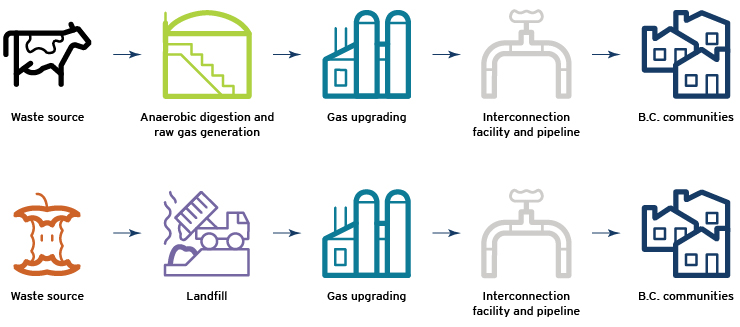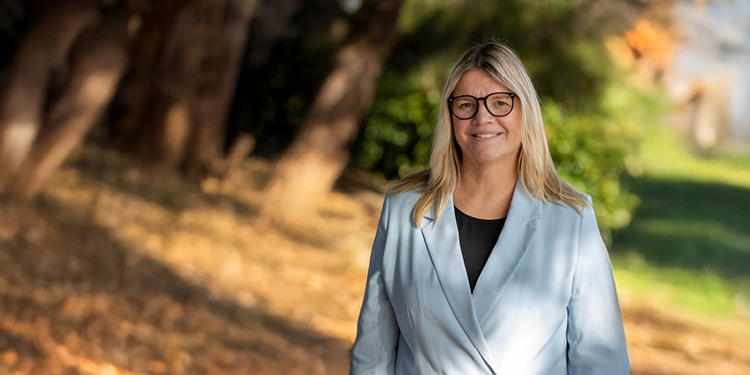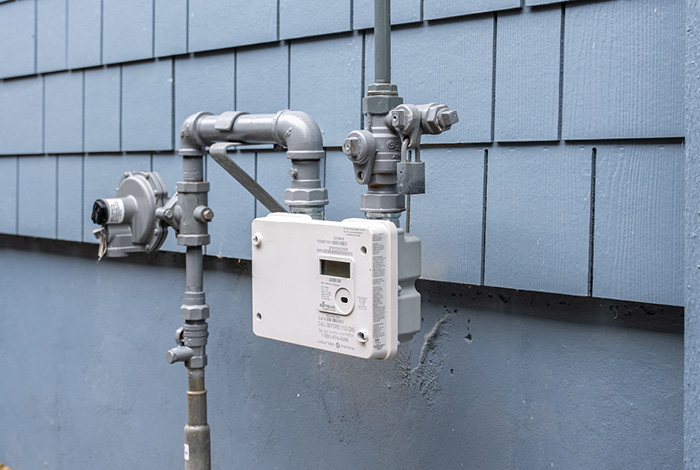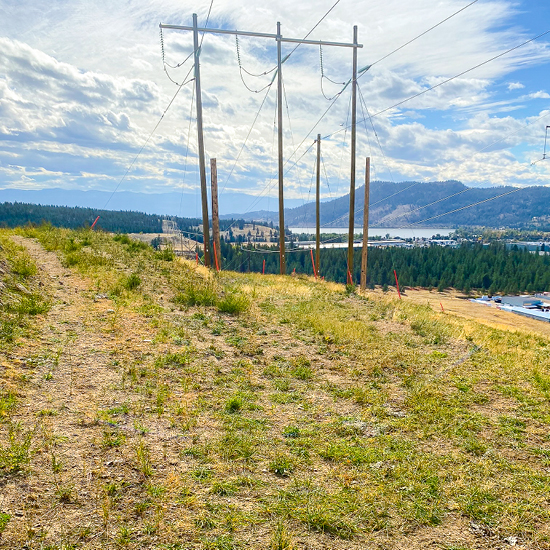5 exciting ways we’re getting renewable and lower carbon gas from waste
January 27, 2021
Updated April 10, 2025
We’re committed to increasing our Renewable Natural Gas1 (RNG) supply. RNG is a lower carbon2 energy and a key part in our commitment to support the energy transition in B.C.
“We’re always looking for innovative, cost-effective ways to increase our renewable and lower carbon gas3 supply through our partnerships with municipalities and industry,” says Scott Gramm, senior manager, renewable and low carbon fuel development at FortisBC. “Our long-term vision is for renewable and lower carbon gas to make up the bulk of the gas we provide to customers, reducing the use of conventional natural gas every year.”
As we work to support B.C.’s energy transition, we’re helping customers switch from conventional marine fuels and diesel to lower carbon fuels like liquefied natural gas (LNG) for ships and compressed natural gas or LNG for truck fleets. We’re also building electric vehicle (EV) charging stations to encourage the use of EVs on B.C. roads. These are key initiatives to a lower carbon future, and with having been approved to invest close to $700 million to help lower customers’ energy use, we can help to further reduce greenhouse gas (GHG) emissions and lower energy costs through energy conservation programs.
How is RNG made?
When bacteria break down organic waste from sources such as landfill sites, agricultural waste and wastewater from treatment facilities, they produce a biogas mostly made of methane. With the right equipment in place, the biogas—which would otherwise escape into the atmosphere—is captured, purified and injected into the local gas distribution system as lower carbon RNG (also called biomethane).
5 ways we’re creating RNG with our municipal and commercial partners:
1. B.C. landfills
Two of the earliest RNG suppliers for FortisBC are Kelowna’s Glenmore Landfill, and the Salmon Arm Landfill. Now, RNG production facilities are under construction at the City of Vancouver’s landfill in Delta, B.C., and the Capital Regional District is working with FortisBC on a supply contract for Victoria’s Hartland Landfill. “This is a significant step forward in our ongoing efforts to maximize the beneficial use of the gas we recover at the landfill,” said Cheryl Nelms, general manager, project delivery, Metro Vancouver.
2. Wastewater
The Lulu Island Renewable Natural Gas Facility in Richmond, B.C. represents the first wastewater RNG plant for FortisBC and the second of its kind in Canada. Owned by Metro Vancouver, it's significant because it creates a model for more wastewater plants in the future.
“Generating Renewable Natural Gas from wastewater treatment is a win-win for residents and the environment, and the Lulu Island Renewable Natural Gas Facility is just one of the innovative climate action projects underway in Metro Vancouver, as we work together toward the goal of becoming a carbon-neutral region by 2050,” said Sav Dhaliwal, member and former chair of the Metro Vancouver Board of Directors. “Partnerships such as this will be key to the success of Climate 2050, our strategy for addressing and reducing the impacts of climate change on regional infrastructure, ecosystems and communities.”
3. Wood waste
Another leap forward for RNG is the first wood waste-to-RNG project in North America. Kelowna-based company REN Energy International Corp. is building a facility in Fruitvale, B.C. It will use waste items like sawdust, wood chips and hog fuel to produce RNG. This innovative project is currently under construction.
4. Residential and municipal organic waste
The City of Surrey created a closed loop organics processing operation: they collect and process curbside organic waste from Surrey residents and businesses to produce RNG. This gas will eventually be used to power Surrey’s waste collection trucks as well as the city’s growing fleet of natural gas-fuelled vehicles. The Surrey Biofuel Facility is the largest of its kind in North America and it processes organic waste from more than 150,000 Surrey households, plus local industrial, commercial and institutional operations and other municipalities in the region.
5. Farm waste
Our farm suppliers use their own agricultural and livestock waste, along with other local organic waste to create RNG. As a byproduct of the RNG process, they also create a nutrient-rich digestate that becomes fertilizer for local crops, creating a sustainable loop of food, waste and energy
Charting a path to 2050
We commissioned Guidehouse Inc., a leading global energy consulting firm, to chart a viable path for B.C. to achieve the provincial government’s commitment to reducing GHG emissions to 80 per cent below 2007 levels by 2050. Guidehouse experts concluded a diversified pathway, with gas and electricity systems working together, could achieve that target for $100 billion less than using electricity as the only energy source.4
FortisBC is committed to pursuing this exciting, diverse approach to meeting our customers’ energy needs while helping the province achieve its greenhouse gas emissions reduction targets. We’re evolving B.C.’s energy landscape and creating innovative partnerships with B.C. communities, businesses, industry and government to make big strides towards a lower carbon future
Scott Gramm, senior manager, renewable and low carbon fuel development, FortisBC
Interested in signing up for RNG, or learning more?
Learn more about RNG, and find out how you can sign up for the voluntary RNG program.
1Renewable Natural Gas (also called RNG or biomethane) is produced in a different manner than conventional natural gas. It is derived from biogas, which is produced from decomposing organic waste from landfills, agricultural waste and wastewater from treatment facilities. The biogas is captured and cleaned to create RNG. When RNG is added to North America’s natural gas system, it mixes with conventional natural gas. This means we’re unable to direct RNG to a specific customer. But the more RNG is added to the gas system, the less conventional natural gas is needed, thereby reducing the use of fossil fuels and overall greenhouse gas emissions.
2When compared to the lifecycle carbon intensity of conventional natural gas. The burner tip emission factor of FortisBC's current Renewable Natural Gas (also called RNG or biomethane) portfolio is 0.27 grams of carbon dioxide equivalent per megajoule of energy (gCO2e/MJ). FortisBC's current RNG portfolio lifecycle emissions for stationary combustion are -22 gCO2e/MJ. This is below B.C.'s lifecycle carbon intensity threshold of 30.8 gCO2e/MJ as set out in the 2024 Greenhouse Gas Reduction Regulation amendments.
3FortisBC uses the term renewable and lower carbon gas to refer collectively to the lower carbon gases or fuels that the utility can acquire under the Greenhouse Gas Reduction (Clean Energy) Regulation, which are: Renewable Natural Gas (also called RNG or biomethane), hydrogen, synthesis gas (from wood waste) and lignin. FortisBC's renewable and lower carbon gas portfolio currently includes only Renewable Natural Gas. Other gases and fuels may be added to the program over time. Depending on their source, all of these gases have differing levels of lifecycle carbon intensity. However, all of these gases are lower carbon when compared to the lifecycle carbon intensity of conventional natural gas. The current burner tip emission factor of RNG is 0.27 grams of carbon dioxide equivalent per megajoule of energy (gCO2e/MJ) and the current renewable and lower carbon gas portfolio lifecycle emissions for stationary combustion are -22 gCO2e/MJ. This is below B.C.'s lifecycle carbon intensity threshold of 30.8 gCO2e/MJ as set out in the 2024 Greenhouse Gas Reduction Regulation amendments.
4Pathways for British Columbia to achieve its GHG reduction goals, Guidehouse, 2020, page 31.



